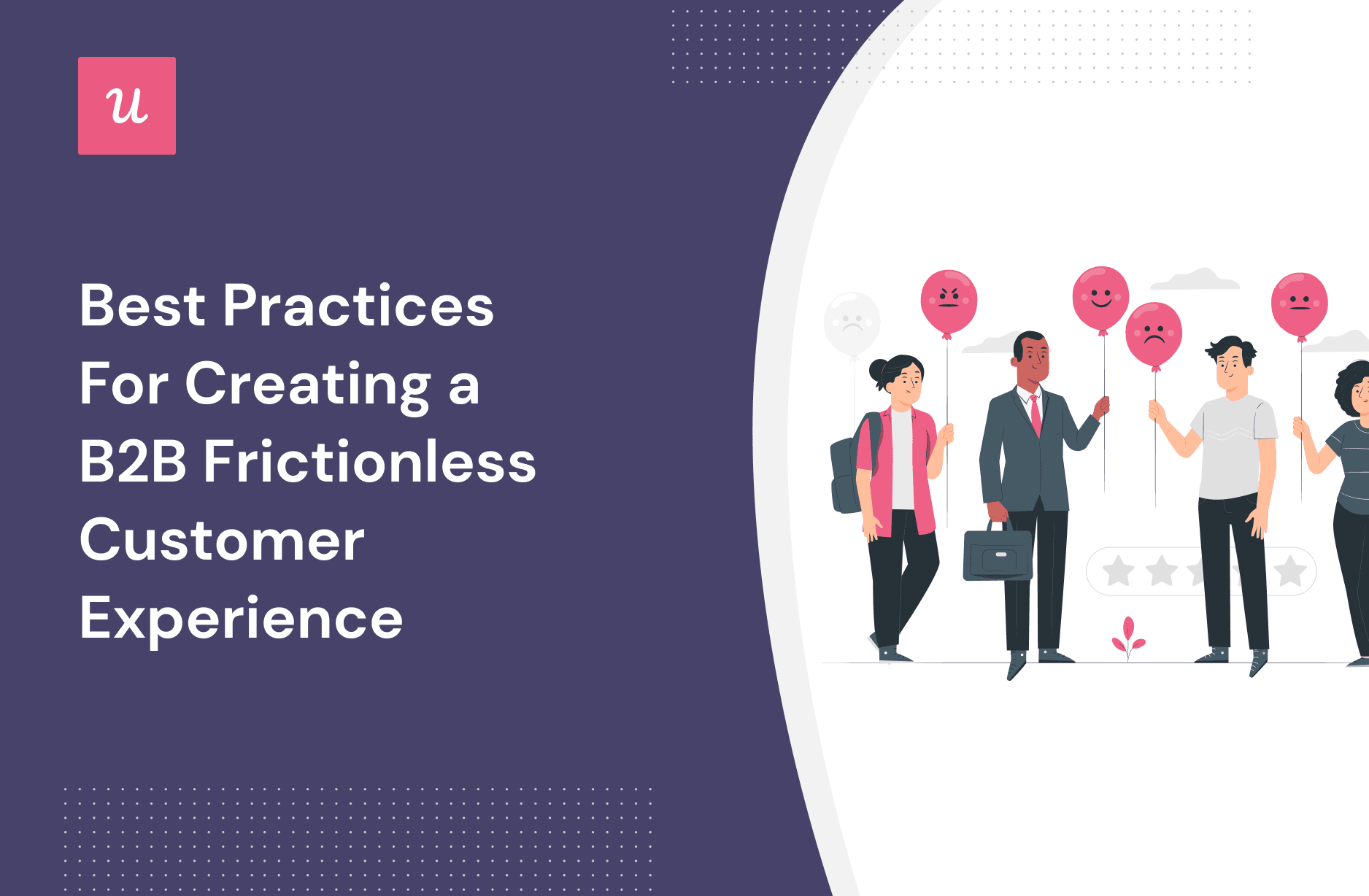
Best Practices For Creating a B2B Frictionless Customer Experience
A frictionless customer experience ensures your customers stay with you for a long time. But it requires dedication and consistency to achieve a frictionless experience for your users.
To help you, we have put together this article with different types of friction, and practical steps to create seamless customer experiences and drive product growth.
Try Userpilot Now
See Why 1,000+ Teams Choose Userpilot

What is a frictionless customer experience?
A frictionless customer experience happens when you identify and remove friction points to ensure customers have smooth sailing with your business. It’s an ongoing process driven by the desire to reduce customer frustrations and help them complete their goals as efficiently as possible.
Customer friction isn’t just the responsibility of the customer service team. It also affects the sales department, marketing team, product team, etc.
Why is having a frictionless customer experience important?
Your product doesn’t suddenly become frictionless. It’s always an intentional effort, and you’ll need to keep making improvements as your SaaS grows. Reducing friction helps to:
- Exceed customer expectations: Think back to the last time you used a tool that just did its job—it wasn’t below your expectations, but there was nothing spectacular either. You probably didn’t leave the product thinking it’s one of the best out there. But investing in frictionless customer experiences will always exceed customer expectations and keep them.
- Improve customer satisfaction: A poor customer experience can lead to churn if left unattained. Proactively prevent that by removing all roadblocks in the user journey.
- Enhance retention: A seamless customer experience motivates customers to stick with your brand. It’s also one of the factors that lead to increased brand loyalty and word of mouth.
What causes customer friction?
There are three main types of user experience friction: emotional, interaction, and cognitive.
Emotional friction refers to the negative emotions the user feels as a result of not being able to effortlessly complete their desired action.
This friction is often the hardest to quantify, but a good example is when new users find it difficult to complete a task on your platform. They’ll have negative emotions from feeling they aren’t tech-savvy enough.
You can combat emotional friction with contextual guidance. Celebrating customers when they hit important milestones also works.
Interaction friction occurs when the product’s interface is confusing or not easily navigable for users.
Example: A poorly designed website that also takes time to load. Users will be totally frustrated, and many will just click the back button.
Users experience cognitive friction when an interface does not function as expected and requires too much mental effort to complete a task.
Examples include having too many steps in a process, using unconventional UI terms that leave users wondering what you mean, etc.

How do you create a frictionless customer experience?
Creating a seamless customer experience is all about understanding your product and audience. In other words, know what customers want and what they expect at every stage in their journey. Here’s how to do that in four practical steps:
Identify customer touchpoints
A customer touchpoint is any interaction prospects customers have with your brand. For example, if someone sees your company ad on Linkedin and clicks it, that’s touchpoint 1. It’s touchpoint 2 when they like the tool and sign up for a demo, and so on.
You can use page analytics to see how your users are navigating through various touchpoints and easily spot friction points which you can explore in more detail.

Map your customer journey
Once you have identified your customer touchpoints, map your customer journey according to the interaction points you’ve noted. This will help you visualize the user journey and help with better analysis.
Note that different SaaS products can have different user journeys regarding their complexity.

Identify friction points and try to fix them
The journey map you created in the previous step will show you the next step customers are expected to take after completing their present tasks (e.g., feature activation after following the onboarding steps).
You know there’s a problem when customers aren’t progressing as they should. Look into the flow and identify what could be causing the friction.

Analyze and improve
Take a deep dive. Use a customer engagement tool like Userpilot to accurately examine each stage of the customer journey, find reasons for poor engagement and improve accordingly.

Best practices for frictionless customer experiences
Ready to start creating frictionless experiences for your new and existing customers? These best practices are your sure guide!
Simplify the signup process
Don’t bombard your new users with long signups. Keep the flow as short and simple as it can be. Implementing Single sign-on (SSO) is also a good idea.
Of course, some products can’t help having lengthy signup flows. If yours fall into that category, follow fullstory’s example and use gamification elements and a progress bar to keep customers hooked.

Create personalized onboarding flows
Without personalized onboarding, customers will be forced to learn aspects of your product that aren’t important to their unique objectives.
They have signed up for your product with specific goals in their mind. Help them achieve these goals effortlessly to avoid friction.
So use a welcome survey to collect customer data. Then segment users according to their JTBDs and create personalized flows leading to user activation.

Train your customer service agents
Even small obstacles like escalated service inquiries can lead to friction. To avoid this, invest in your customer service agents.
They play an important role in creating a frictionless customer experience. But they’d be handicapped without adequate training. So, train them regarding what to do with different customer pain points. Investing in their competence can be the key you need to reduce your churn rate.
Provide frictionless customer service
No matter how competent, there’s only so much your customer service team can do. Augment their efforts by providing self-service customer support to answer frequent questions, educate customers, etc.
A good example of self-service is a resource center—a portal on your website or in-app that’s enriched with content to help customers solve simple problems on their own.

Use surveys to unveil customer friction
Sometimes you just have to hear it from the horse’s mouth. A well-crafted survey delivered contextually will tell you how customers feel about your brand and help you identify friction points.
Use NPS, CSAT, feature surveys, etc, to collect feedback throughout the customer journey. You want to make the survey as effective as possible, so adding quantitative and qualitative questions will give you an overall idea of how your customers feel about a particular segment of your product.
Moreover, you can trigger them after a specific interaction to increase the number of response rates and get the latest feedback.

Perform customer experience analysis
Customer experience analysis involves collecting customer data and analyzing it to understand your users better. This process also helps you uncover the drivers of customer behavior and find friction points.
Six essential CX metrics you should track:
- Customer Satisfaction Score (CSAT)
- Customer Effort Score (CES)
- Net Promoter Score (NPS)
- Customer Lifetime Value (CLV)
- Retention Rate
- Customer Churn Rate.
How to create a frictionless customer experience with Userpilot
Userpilot is a powerful product adoption platform that enables you to quickly build personalized, flexible, contextually relevant in-app experiences targeted to different user segments—all without writing a line of code.
Here are the details of how our platform can help:
Build personalized experience with different UI elements
You can build a huge variety of user onboarding experiences and in-app guidance flows without needing to code. Userpilot lets you do this by granting you access to the largest range of customizable UI patterns (modals, slideouts, tooltips, hotspots, banners) and in-app onboarding templates.
Furthermore, with our native mobile SDK, you can extend these personalized experiences to your mobile app users by creating targeted onboarding flows, slideouts, carousels, and push notifications—all without writing extra code. Our platform also allows you to build in-app self-service portals with simple clicks.

Collect customer data with in-app surveys
Get access to a built-in NPS tool for collecting and analyzing user sentiment so you can improve your onboarding process based on real data.
But it’s not just NPS. Our platform equally allows you to build other types of in-app surveys—CSAT, feature surveys, etc—so you have many options and can choose the survey that best suits your purpose.

Conclusion
Your customers came for what they think your product can help them solve, but they’d stay for the experience. Nobody wants to continue using a product that falls short of their expectation and always leaves them frustrated.
That’s why you shouldn’t wait another day. Go ahead and start creating the frictionless customer experience your users are craving! Book a demo now to discuss your specific needs with our team.





